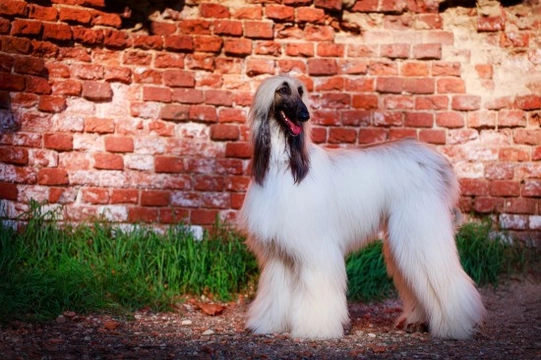
Is the Afghan hound a good choice of pet?
The Afghan hound is definitely one of the most distinctive dog breeds, with their lean builds and incredibly long, flowing coats. They are extremely elegant and beautiful to look at, and have a very smooth moving gait. They are also one of the world’s oldest known dog breeds that still exist today, and originate from the cold, mountainous regions of Afghanistan.
The Afghan hound is one of the breeds that falls into the sighthound grouping, meaning that they have superior eyesight compared to most dogs, and a strong prey drive that manifests as a propensity to hunt by sight. Genetic testing of the Afghan hound has identified that the breed has the lowest degree of genetic variance from the grey wolf of any dog breed for certain genetic markers, which identifies it as one of the most ancient breeds of dog.
Afghan hounds within the UK today are the descendants of imported dogs that were brought to Britain during the 1920’s, and are a mixture of various different sighthound variants that occur naturally within Afghanistan. Historically used as hunting dogs, today, the Afghan hound is much more widely kept as a domestic pet.
If you have fallen for the undeniable appeals of the Afghan hound’s appearance, you might be wondering what is involved in ownership of dogs of the breed, and whether or not they make for good family pets. In this article, we will cover some of the traits and care requirements of the Afghan hound in more detail. Read on to learn more.
How much care do their coats require?
The coat of the Afghan hound is among the highest maintenance of all dog breeds in terms of its care requirements, and committing to take care of their coats is something that you should think about carefully!
They need a thorough brushing and grooming on a daily basis, and the coat will soon become knotted and unkempt if this is neglected. Special attention should be paid to combing out the undercoat, and paying attention to the area under the belly and between the legs, as these areas are prone to matting up. The Afghan hound does also tend to pick up a fair amount of muck in their coats when out on walks, and so bathing on a regular basis may be required too!
Do they have a strong prey drive?
Like all sighthounds, the prey drive of the Afghan hound is pronounced and very strong. This means that outside of the home, they are apt to be on the lookout for the signs of movement of potential prey, and will have a tendency to take off after it with little warning!
This means that the dog should always be walked on the lead other than when within a safe, enclosed space to run, and you may need to consider muzzling the dog for the protection of smaller animals.
Are they easy to train?
The Afghan hound is ranked at the very bottom of Stanley Coren’s definitive listing of canine intelligence, which means that they are unlikely to be able to retain a wide range of training commands. Basic commands such as walking to heel, sit, and stay should be achievable, but do not expect too much from the Afghan hound, or you may be disappointed!
It can be very hard to train the Afghan hound for effective recall, both due to their strong prey drive and low intelligence ranking, which means that a watchful eye and constant supervision is required outside of the home.
How much exercise do they need?
Like all sighthounds, the Afghan hound can be very fast on their feet, and can cover short distances very quickly when the urge takes them. However, they are built for sprinting rather than marathons, and so they do not have a particularly high level of endurance for exercise.
Walking on the lead and a couple of opportunities per day to run and stretch their legs is fine for the Afghan hound, and they do not have particularly onerous exercise requirements as a whole.
What types of home do they suit?
The Afghan hound loves to be the centre of attention, and they are very affectionate dogs that like to stay close to their owners. They actively enjoy grooming and thrive on love and kind care, and do not like to be left out of things or spend long periods of time on their own.
They are fairly quiet within the home and are not prone to being destructive, but as they are large and have long tails, may be prone to knocking things over if the home is cramped! They like their creature comforts, such as a warm bed or sofa, and enjoy sitting quietly with the family while you go about your general business.



